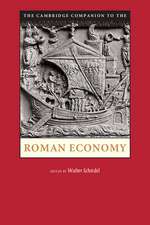The Topography of Violence in the Greco-Roman World
Autor Werner Riess, Garrett G. Faganen Limba Engleză Hardback – 14 iun 2016
What soldiers do on the battlefield or boxers do in the ring would be treated as criminal acts if carried out in an everyday setting. Perpetrators of violence in the classical world knew this and chose their venues and targets with care: killing Julius Caesar at a meeting of the Senate was deliberate. That location asserted Senatorial superiority over a perceived tyrant, and so proclaimed the pure republican principles of the assassins.
The contributors to The Topography of Violence in the Greco-Roman World take on a task not yet addressed in classical scholarship: they examine how topography shaped the perception and interpretation of violence in Greek and Roman antiquity. After an introduction explaining the “spatial turn” in the theoretical study of violence, “paired” chapters review political assassination, the battlefield, violence against women and slaves, and violence at Greek and Roman dinner parties. No other book either adopts the spatial theoretical framework or pairs the examination of different classes of violence in classical antiquity in this way.
Both undergraduate and graduate students of classics, history, and political science will benefit from the collection, as will specialists in those disciplines. The papers are original and stimulating, and they are accessible to the educated general reader with some grounding in classical history.
The contributors to The Topography of Violence in the Greco-Roman World take on a task not yet addressed in classical scholarship: they examine how topography shaped the perception and interpretation of violence in Greek and Roman antiquity. After an introduction explaining the “spatial turn” in the theoretical study of violence, “paired” chapters review political assassination, the battlefield, violence against women and slaves, and violence at Greek and Roman dinner parties. No other book either adopts the spatial theoretical framework or pairs the examination of different classes of violence in classical antiquity in this way.
Both undergraduate and graduate students of classics, history, and political science will benefit from the collection, as will specialists in those disciplines. The papers are original and stimulating, and they are accessible to the educated general reader with some grounding in classical history.
Preț: 568.70 lei
Preț vechi: 738.57 lei
-23% Nou
Puncte Express: 853
Preț estimativ în valută:
108.82€ • 113.39$ • 90.10£
108.82€ • 113.39$ • 90.10£
Carte tipărită la comandă
Livrare economică 03-17 aprilie
Preluare comenzi: 021 569.72.76
Specificații
ISBN-13: 9780472119820
ISBN-10: 0472119826
Pagini: 422
Ilustrații: 14 halftones, 3 tables
Dimensiuni: 152 x 229 x 30 mm
Greutate: 0.77 kg
Editura: UNIVERSITY OF MICHIGAN PRESS
Colecția University of Michigan Press
ISBN-10: 0472119826
Pagini: 422
Ilustrații: 14 halftones, 3 tables
Dimensiuni: 152 x 229 x 30 mm
Greutate: 0.77 kg
Editura: UNIVERSITY OF MICHIGAN PRESS
Colecția University of Michigan Press
Notă biografică
Werner Riess is Chair of Ancient History at the University of Hamburg. Garrett G. Fagan is Professor of Ancient History at Pennsylvania State University.
Recenzii
“A must for libraries in all colleges that are delivering degrees in classics, classical civilization and ancient history. . . . Readily accessible to a wide-ranging audience from specialists to undergraduates and general nonspecialist readers.”
—Kate Gilliver, Cardiff University
—Kate Gilliver, Cardiff University
"This collection of essays seeks to explore some of the topographical and circumstantial aspects that helped define violence in
antiquity, focusing on how Greeks and Romans charged violent acts with specific meanings on the basis of situation and space." - New Testament Abstracts
antiquity, focusing on how Greeks and Romans charged violent acts with specific meanings on the basis of situation and space." - New Testament Abstracts
Descriere
Examines how location confers cultural meaning on acts of violence, and renders them socially acceptable—or not
















